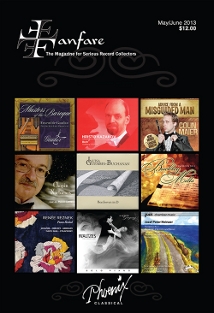Texte paru dans: / Appeared in:

Fanfare Magazine: 36:5 (05-06/2013)
Pour
s'abonner / Subscription information
Les abonnés à Fanfare Magazine ont accès aux archives du
magazine sur internet.
Subscribers to Fanfare Magazine have access to the archives of the magazine
on the net.
DHM
DHM7901822

Code-barres / Barcode : 0886979018228
Consultez toutes les évaluations recensées pour ce cd
~~~~ Reach all the evaluations located for this CD
The rarest of 18th-century beasts is a complete and unalterable opera by a single composer. Now before everyone starts sharpening their quills to refute this statement, I would ask that one look at opera from an 18th-century perspective. First, very few if any composers actually believed that whatever they wrote would be considered a fixed and immutable object. From the premiere onwards, and sometimes even before, composers of the period regularly reworked and modified their operas to suite the various circumstances, which ranged from a wholesale reinvention of a work (Gluck’s French and Italian Orfeos come to mind) to minatory tweaks such as the substitution of an aria here, a duet there. As far as I am aware, few new works promised fixed and uncut versions back then, and a wide range of folks, from the composers themselves to various impresarios, singers, arrangers, librettists, conductors, and assorted others, all eagerly and continually revamped the works, save only in those instances where a work was such a dismal failure or for such a singular occasion as to be tossed aside after only a single performance. Moreover, bits and pieces of works were regularly plucked from the opera to which they belonged and given new life, either as insertions into other works, as concert pieces, or as arrangements for the general public. The reason for this short digression is that this disc is a conglomeration of miscellaneous vocal pieces written by Georg Philipp Telemann for sundry occasions; a set of published cantatas from 1731, a larger secular cantata from which the disc takes its title, Hoffnung des Wiedersehens, and fragments from a lost Leipzig opera, as well as a number of arias written for insertion into the works of others, namely here Reinhard Keiser and George Frederick Handel. The latter, composed on demand, were one-offs, generally meant to replace something else in the originals, which today few if any recordings would dare to include in their “authentic” versions of, say, Almira or Janus. The issue for the modern ensemble therefore becomes one of how to present these orphans to an audience.
What conductor Michi Gaigg and the Orfeo Barockorchester have done is to cobble together a pastiche that seems to have a thread of love longed for, unrequited, betrayed, and finally revived running throughout. Taking as the point of departure the highly variable nature of operas in the period, the authors have used the framework to attach the various insertion arias and other works to make a complete story. I remain unconvinced that this is either viable or successful as a premise, but at least it offers the opportunity to sample music that otherwise might never see the light of day. The disc has Telemann’s Violin Concerto, TWV 22:6, a work that has some recording history but here is used both as an overture (all three-movement) and an epilogue (only the first movement). As an interlude, one of the oboe d’amore concertos, this one the second in E Minor which has already been recorded on EMI back in 2002 and elsewhere, is used. The violin concerto, which was also used as an overture for Keiser’s Nebucadnezar, is a three-movement work with a rapid paced first movement with busy figuration, a contemplative second, and a triple meter stylized dance third. The solo part, though at times gnarly, is hardly at a supreme virtuoso level of demand, but it is nicely phrased by Martin Jopp, especially in the lyrical, pensive second movement. Likewise, the oboe d’amore concerto is ably played by Carin van Heerden, though it too is a somewhat sedate piece.
The real star of this disc is soprano Dorothee Mields, whose clear and pure voice carries the various arias. Telemann’s insertions for Keiser’s operas are all very close to cantata arias by Johann Sebastian Bach in their fluid and meandering themes that seem to evolve musically. She handles these twists and turns with considerable ease, always on pitch and finely detailing the various musical phrase perambulations. Take the aria “Mein Vergnügen wird sich fügen,” where a rather virtuoso flute line above the strings’ pizzicato merges into a light and airy Bachian line that is almost galant in style. In another, the second insertion aria for Handel’s Richardus I, “Genug geklaget,” the flowing lyrical line begins almost as a spare continuo aria, with the strings entering only cautiously to punctuate the fluid vocal part. In “Fliessen nichts als bitter Tränen,” the transverse flute makes a plaintive minuet, to which Mields weaves an ethereal and subtly ornamented line that dips and swirls gently. Her voice is always on pitch, each ornament clearly enunciated and each phrase carefully outlined to bring out the best in the music. Gaigg’s ensemble is equally genteel and finely phrased, with good tempos and a pure tone that blends with the voice without overpowering or underplaying it. In short, the arias themselves are small gems, here performed with grace and skill. Whatever one might think of the premise of linking them together in a sort of concocted story, the beauty of the music is captivating. This is one disc of rarities that will delight.
Cliquez l'un ou l'autre
bouton pour découvrir bien d'autres critiques de CD
Click either button for many other reviews


